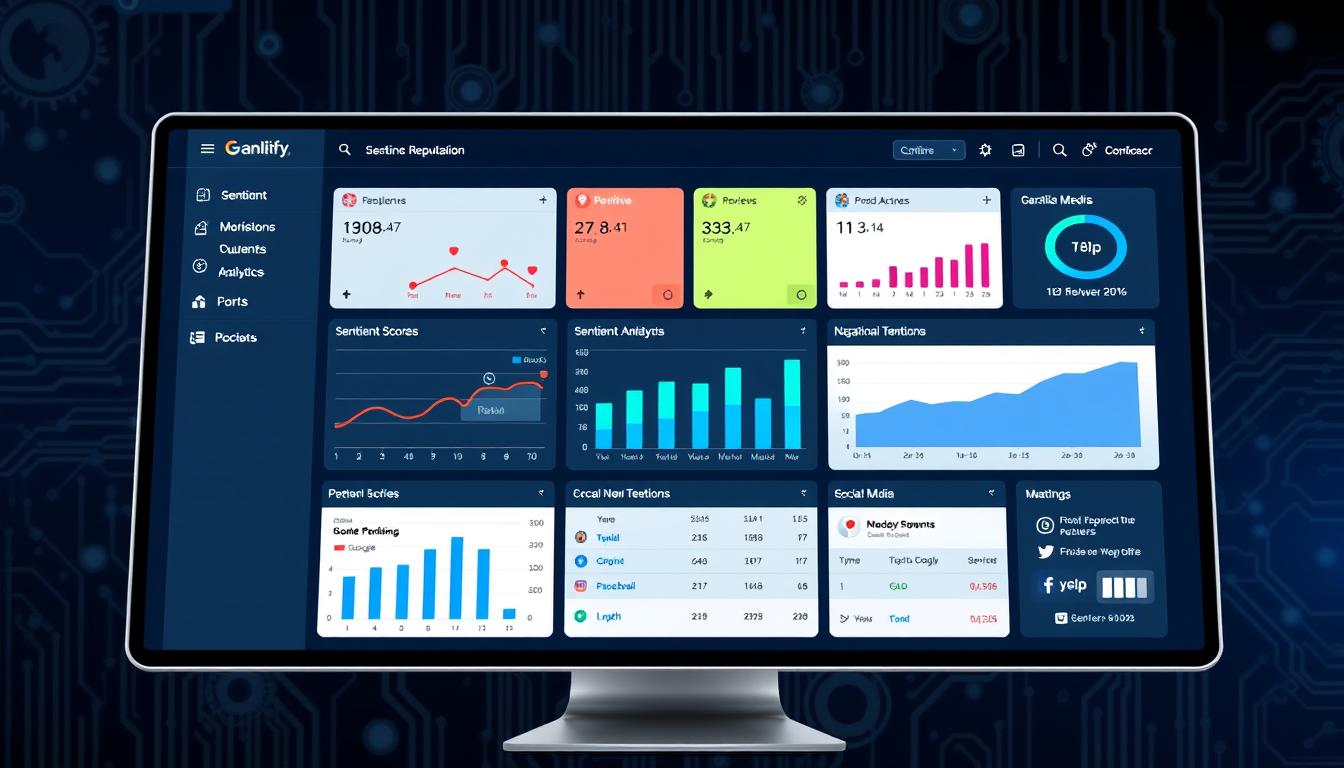Ever wonder how a single mistake can ruin a company’s reputation today? In our connected world, a business’s online image is key to success. We’ve seen big names and new startups fall because of bad reputation issues. Let’s look at some case studies to learn from these online reputation failures.
Managing a company’s online image is more critical than ever. A recent study found that brand reputation is the top worry for businesses, with over half of executives seeing it as their main concern1. This makes sense, since 97% of people check out a business online first1.
Trust is crucial online, and a good online reputation gives businesses an edge. An amazing 95% of consumers trust companies with a strong online image1. But, 90% of people avoid businesses with bad reputations1.
Bad publicity can hit hard and fast. A single negative article online can lose a business up to 22% of customers, and that jumps to 70% with four or more negative pieces1. With 86% of Americans getting news online, public opinion matters a lot1.
Key Takeaways
- Brand reputation is the top strategic risk for businesses
- 97% of people research businesses online
- 95% of consumers trust businesses with positive online reputations
- Negative publicity can cost businesses up to 70% of potential customers
- 86% of Americans rely on online news sources
- Online reputation management is crucial for business success
- Addressing negative feedback promptly is essential for reputation repair
Understanding Online Reputation Management
Online reputation management is key for today’s businesses. It shapes how people see a brand online. It means making sure the brand lives up to its promises. This includes watching reviews, answering feedback, and keeping a strong brand image on different platforms.
Good reputation management uses advanced tools to look at both inside and outside data. These tools give a full picture of how a brand is doing. They help predict what customers will think and offer ways to boost reputation scores. With these tools, companies can keep an eye on their reputation and make smart choices to improve their online image.
Building trust is a main goal of reputation management. Companies that focus on their reputation often do better financially2. This shows how a strong reputation can lead to success. For example, Starbucks closed over 8,000 U.S. stores for racial bias training. This bold move showed they were serious about fixing their reputation2.
Handling feedback well is key to a good online reputation. It means talking with customers on different platforms. By quickly and professionally addressing concerns, companies can turn negatives into chances to get better. This shows they care about making customers happy.
In crises, being open helps rebuild trust. Johnson & Johnson’s move during the Tylenol crisis in 1982 is a great example. They pulled 31 million bottles from the market, putting safety first2. This honest step helped them win back trust, showing how important being open is in managing reputation2.
By focusing on these areas, companies can build a strong online presence that matches their brand and meets what customers want. This active approach to managing reputation can lead to more positive reviews, loyal customers, and a stronger financial outcome.
Common Causes of Poor Online Reputations
A company’s online presence is key to its success. Today, 70% to 80% of a business’s value comes from things like brand value and goodwill3. It’s vital to know what causes poor online reputations to help businesses succeed online.

Negative reviews are a big problem. Most customers check out reviews online before visiting a place, so bad feedback can hurt a lot4. If customer complaints go ignored, they can turn into big PR issues. A single star on Yelp can even boost a business’s sales by up to 9%, showing how crucial good reviews are4.
Mistakes on social media can quickly hurt a brand. Things like posting at the wrong time or sharing personal stuff on company accounts can cause a backlash. Being active on social media is key, as not engaging with customers can lead to losing up to 15% of them4.
When products fail or have quality issues, it leads to bad feedback. How employees act online and offline reflects on the company. If false info or rumors spread, it can damage trust in the brand if not fixed quickly.
| Reputation Factor | Impact |
|---|---|
| Online Reviews | 97% of consumers say reviews influence their purchasing decisions4 |
| Negative Reviews | 60% of consumers avoid businesses with negative reviews5 |
| Social Media Influence | 66% of Gen-Z and 72% of millennials say it affects their buying decisions5 |
Most consumers trustworthiness deeply with their favorite brands5. Companies with strong reputations are seen as offering more value. They can charge more and attract better talent3. By fixing these issues, businesses can build a strong online presence and keep customers coming back.
Case Studies: Online Reputation Failures
We’ve seen many brand reputation crises that show how crucial online presence management is. Let’s look at some key cases. They highlight the effects of social media backlash and PR disasters.

Samsung had a big crisis with its Galaxy Note 7 recall. The company’s shares fell 6.3% from $1432 to $1341.82 per share. This led to a huge $14.3 billion loss in market value6.
Volkswagen’s 2015 emissions scandal is another example of how a company can be damaged. The company lost €30 billion after it was found that 11 million cars had devices to hide emissions7. This scandal caused a big drop in Volkswagen’s shares and hurt their brand image for a long time.
Social media can make customer service failures go viral fast. Burger King got over 140,000 online mentions in one day because of a tweet on International Women’s Day7. This shows how quickly negative content can spread, causing a big backlash.
| Company | Incident | Impact |
|---|---|---|
| Samsung | Galaxy Note 7 Recall | $14.3 billion market cap loss |
| Volkswagen | Emissions Scandal | €30 billion hit |
| Burger King | Controversial Tweet | 140,000+ negative mentions |
These examples show how important it is for businesses to watch their online reputation. With 75% of HR departments checking candidates online before hiring, and 70% rejecting them because of their online presence, keeping a good digital image is key8.
Consequences of Neglecting Online Reputation

Ignoring your online reputation can hurt your business a lot. You might lose sales and see trust drop. A big 94% of customers say a bad review made them avoid a business9. This shows how a poor online image affects customer choices and sales.
Having a bad online image also makes it hard to attract top talent. Good candidates don’t want to work for companies with bad names. This limits your access to skilled people. Being hard to find online, with 75% of users not going past the first page9, makes things worse. This can lead to losing customers and hurting your brand’s value.
The financial hit is big too. Companies can lose up to 20% of their value over five years because of a bad reputation10. But, managing your online image well can boost sales by 5-9% for every star you improve your ratings10. This shows how important it is to keep a good online image.
“Reputation is seen as the most valuable asset by CEOs, showing how vital it is to keep and improve your brand’s reputation.”
To avoid these problems, businesses need to focus on managing their online reputation. It’s key to quickly answer customer feedback, as 79% of consumers expect a fast reply on social media9. By dealing with concerns fast and openly, companies show they care about customer satisfaction and protect their brand.
In today’s digital world, having a strong online reputation is crucial for success. Ignoring this can cause a chain of negative effects, from losing sales to losing trust, and big financial losses.
Strategies for Rebuilding a Damaged Online Reputation

Rebuilding a damaged online reputation is key in today’s digital world. With 93% of customers reading online reviews before buying, ignoring your online presence is not an option11. A strong plan for managing your reputation is vital for handling crises and engaging with customers.
To begin fixing your reputation, use social listening tools. These tools track what customers think and what’s happening in your industry. This lets you quickly respond to negative feedback. Also, having a strong content marketing plan is crucial. By sharing the good things about your brand, you can change how people see you.
Getting people to support your brand is also important. Ask your employees to share good things about your brand on social media. This can really help, as even one more star on Yelp can increase sales by up to 9%1112.
Fixing your online reputation is tough, but it’s doable. It might take a few weeks or several months to see big changes12. Remember, 88% of brand leaders see managing reputation risk as a major concern13.
“Your reputation is your most valuable asset. Protect it, nurture it, and watch your business thrive.”
By using these strategies and focusing on managing your reputation, businesses can rebuild their online image and win back customer trust.
Conclusion
Managing your reputation online is key in today’s world. It affects how customers trust you and your success over time. Having a strong digital brand is crucial for growing your business. Social media is a big deal, with 73% of teens using it every day14.
For companies, your online reputation can change everything. About 43% of employers won’t hire someone because of what they find online. On the other hand, 19% have hired someone because of their online presence14. This shows how important it is for both people and companies to manage their online image well.
How people act shows just how much they care about online reviews. A huge 97% of shoppers check reviews online before buying something, and 94% trust products with good ratings15. Also, 86% are less likely to buy from companies with bad reviews15. These numbers prove that managing your online reputation is key to gaining customer trust and doing well online.
FAQ
What is online reputation management?
Why is online reputation management important?
What causes poor online reputations?
What are some examples of online reputation failures?
What are the consequences of neglecting online reputation?
How can a damaged online reputation be rebuilt?
Why is effective online reputation management crucial for long-term business success?
Source Links
- Assessing the Risk of Reputational Damage – https://statuslabs.com/blog/what-is-reputational-risk-damage
- Reputation Management Case Studies: Big Brand Turnarounds – https://bryghtpath.com/reputation-management-case-studies/
- Reputation and Its Risks – https://hbr.org/2007/02/reputation-and-its-risks
- How Your Online Reputation Impacts Your Business – https://www.linkedin.com/pulse/how-your-online-reputation-can-impact-business-antonio-calabrese-u1soc
- 2024 Online Reputation Management Statistics – https://blog.reputationx.com/online-reputation-management-statistics
- Case Study: Reputation Management – https://www.linkedin.com/pulse/case-study-reputation-management-harsha-gupta
- Reputation crisis management: top-5 cases – https://youscan.io/blog/reputation-crisis-cases/
- The Case For Online Reputation Management: By The Numbers – https://www.forbes.com/sites/johnhall/2017/03/12/the-case-for-online-reputation-management-by-the-numbers/
- How to Fix Your Online Reputation (10 Steps) – https://sachsmarketinggroup.com/how-to-fix-your-online-reputation-10-steps/
- Managing Online Reviews, Online Reputation Management – https://www.cignex.com/blog/ignoring-online-reputation-management-silent-killer-businesses
- 5 Easy Steps to Repair Your Online Reputation – https://www.crazyegg.com/blog/how-to-repair-your-online-reputation/
- 7 Ways to Repair Online Reputation for Your Small Business – https://www.podium.com/article/ways-to-repair-online-reputation/
- Rebuilding a Damaged Reputation | Consultus Digital – https://consultusdigital.com/blog/from-crisis-to-recovery-strategies-for-rebuilding-a-damaged-reputation/
- PDF – https://files.eric.ed.gov/fulltext/EJ1230308.pdf
- The Impact of Online Reputation on Consumer Perception and Purchase Behavior – https://www.linkedin.com/pulse/impact-online-reputation-consumer-perception-purchase-devin-miller-3m1nc

